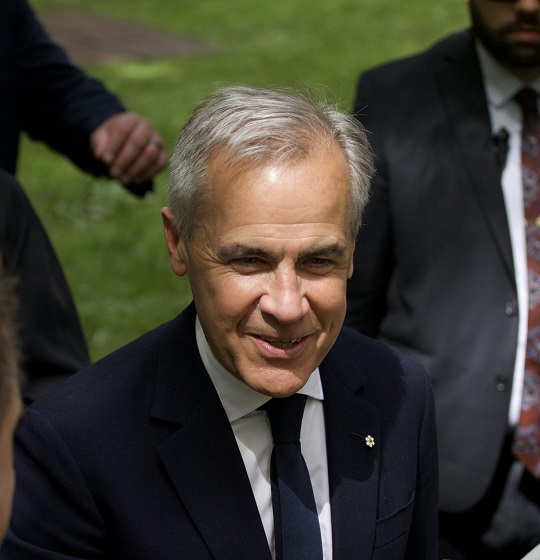Economy
Canada should not want to lead the world on climate change policy

From the Fraser Institute
Some commentators in the media want the the federal Conservatives to take a leadership position on climate, and by extension make Canada a world leader on the journey to the low-carbon uplands of the future. This would be a mistake for three reasons.
First, unlike other areas such as trade, defence or central banking, where diplomats aim for realistic solutions to identifiable problems, in the global climate policy world one’s bona fides are not established by actions but by willingness to recite the words of an increasingly absurd creed. Take, for example, United Nations Secretary General António Guterres’ fanatical rhetoric about the “global boiling crisis” and his call for a “death knell” for fossil fuels “before they destroy our planet.” In that world no credit is given for actually reducing emissions unless you first declare that climate change is an existential crisis, that we are (again, to quote Guterres) at the “tip of a tipping point” of “climate breakdown” and that “humanity has become a weapon of mass extinction.” Any attempt to speak sensibly on the issue is condemned as denialism, whereas any amount of hypocrisy from jet-setting politicians, global bureaucrats and celebrities is readily forgiven as long as they parrot the deranged climate crisis lingo.
The opposite is also true. Unwillingness to state absurdities means actual accomplishments count for nothing. Compare President Donald Trump, who pulled out of the Paris treaty and disparaged climate change as unimportant, to Prime Minister Justin Trudeau who embraced climate emergency rhetoric and dispatched ever-larger Canadian delegations to the annual greenhouse gabfests. In the climate policy world, that made Canada a hero and the United States a villain. Meanwhile, thanks in part to expansion of natural gas supplies under the Trump administration, from 2015 to 2019 U.S. energy-based CO2 emissions fell by 3 per cent even as primary energy consumption grew by 3 per cent. In Canada over the same period, CO2 emissions fell only 1 per cent despite energy consumption not increasing at all. But for the purpose of naming heroes and villains, no one cared about the outcome, only the verbiage. Likewise, climate zealots will not credit Conservatives for anything they achieve on the climate file unless they are first willing to repeat untrue alarmist nonsense, and probably not even then.
On climate change, Conservatives should resolve to speak sensibly and use mainstream science and economic analysis, but that means rejecting climate crisis rhetoric and costly “net zero” aspirations. Which leads to the second problem—climate advocates love to talk about “solutions” but their track record is 40 years of costly failure and massive waste. Here again leadership status is tied to one’s willingness to dump ever-larger amounts of taxpayer money into impractical schemes loaded with all the fashionable buzzwords. The story is always the same. We need to hurry and embrace this exciting economic opportunity, which for some reason the private sector won’t touch.
There are genuine benefits to pursuing practical sensible improvements in the way we make and use fossil fuels. But the current and foreseeable state of energy technology means CO2 mitigation steps will be smaller and much slower than was the case for other energy side-effects such as acid rain and particulates. It has nothing to do with lack of “political will;” it’s an unavoidable consequence of the underlying science, engineering and economics. In this context, leadership means being willing sometimes to do nothing when all the available options yield negative net benefits.
That leads to the third problem—opportunity cost. Aspiring to “climate leadership” means not fixing any of the pressing economic problems we currently face. Climate policy over the past four decades has proven to be very expensive, economically damaging and environmentally futile. The migration of energy-intensive industry to China and India is a very real phenomenon and more than offsets the tiny emission-reduction measures Canada and other western countries pursued under the Kyoto Protocol.
The next government should start by creating a new super-ministry of Energy, Resources and Climate where long-term thinking and planning can occur in a collaborative setting, not the current one where climate policy is positioned at odds with—and antagonistic towards—everything else. The environment ministry can then return its focus to air and water pollution management, species and habitat conservation, meteorological services and other traditional environmental functions. The climate team should prepare another national assessment but this time provide much more historical data to help Canadians understand long-term observed patterns of temperature and precipitation rather than focusing so much on model simulations of the distant future under implausible emission scenarios.
The government should also move to extinguish “climate liability,” a legal hook on which dozens of costly nuisance lawsuits are proliferating here and elsewhere. Canada should also use its influence in the UN Intergovernmental Panel on Climate Change to reverse the mission creep, clean out the policy advocacy crowd and get the focus back on core scientific assessments. And we should lead a push to move the annual “COPs”—Conferences of the Parties to the Rio treaty—to an online format, an initiative that would ground enough jumbo jets each year to delay the melting of the ice caps at least a century.
Finally, the new Ministry of Energy, Resources and Climate should work with the provinces to find one region or municipality willing to be a demonstration project on the feasibility of relying only on renewables for electricity. We keep hearing from enthusiasts that wind and solar are the cheapest and best options, while critics point to their intermittency and hidden costs. Surely there must be one town in Canada where the councillors, fresh from declaring a climate crisis and buying electric buses, would welcome the chance to, as it were, show leadership. We could fit them out with all the windmills and solar panels they want, then disconnect them from the grid and see how it goes. And if upon further reflection no one is willing to try it, that would also be useful information.
In the meantime, the federal Conservatives should aim merely to do some sensible things that yield tangible improvements on greenhouse gas emissions without wrecking the economy. Maybe one day that will be seen as real leadership.
Author:
Automotive
Federal government should swiftly axe foolish EV mandate

From the Fraser Institute
Two recent events exemplify the fundamental irrationality that is Canada’s electric vehicle (EV) policy.
First, the Carney government re-committed to Justin Trudeau’s EV transition mandate that by 2035 all (that’s 100 per cent) of new car sales in Canada consist of “zero emission vehicles” including battery EVs, plug-in hybrid EVs and fuel-cell powered vehicles (which are virtually non-existent in today’s market). This policy has been a foolish idea since inception. The mass of car-buyers in Canada showed little desire to buy them in 2022, when the government announced the plan, and they still don’t want them.
Second, President Trump’s “Big Beautiful” budget bill has slashed taxpayer subsidies for buying new and used EVs, ended federal support for EV charging stations, and limited the ability of states to use fuel standards to force EVs onto the sales lot. Of course, Canada should not craft policy to simply match U.S. policy, but in light of policy changes south of the border Canadian policymakers would be wise to give their own EV policies a rethink.
And in this case, a rethink—that is, scrapping Ottawa’s mandate—would only benefit most Canadians. Indeed, most Canadians disapprove of the mandate; most do not want to buy EVs; most can’t afford to buy EVs (which are more expensive than traditional internal combustion vehicles and more expensive to insure and repair); and if they do manage to swing the cost of an EV, most will likely find it difficult to find public charging stations.
Also, consider this. Globally, the mining sector likely lacks the ability to keep up with the supply of metals needed to produce EVs and satisfy government mandates like we have in Canada, potentially further driving up production costs and ultimately sticker prices.
Finally, if you’re worried about losing the climate and environmental benefits of an EV transition, you should, well, not worry that much. The benefits of vehicle electrification for climate/environmental risk reduction have been oversold. In some circumstances EVs can help reduce GHG emissions—in others, they can make them worse. It depends on the fuel used to generate electricity used to charge them. And EVs have environmental negatives of their own—their fancy tires cause a lot of fine particulate pollution, one of the more harmful types of air pollution that can affect our health. And when they burst into flames (which they do with disturbing regularity) they spew toxic metals and plastics into the air with abandon.
So, to sum up in point form. Prime Minister Carney’s government has re-upped its commitment to the Trudeau-era 2035 EV mandate even while Canadians have shown for years that most don’t want to buy them. EVs don’t provide meaningful environmental benefits. They represent the worst of public policy (picking winning or losing technologies in mass markets). They are unjust (tax-robbing people who can’t afford them to subsidize those who can). And taxpayer-funded “investments” in EVs and EV-battery technology will likely be wasted in light of the diminishing U.S. market for Canadian EV tech.
If ever there was a policy so justifiably axed on its failed merits, it’s Ottawa’s EV mandate. Hopefully, the pragmatists we’ve heard much about since Carney’s election victory will acknowledge EV reality.
Economy
The stars are aligning for a new pipeline to the West Coast

From Resource Works
Mark Carney says another pipeline is “highly likely”, and that welcome news.
While attending this year’s Calgary Stampede, Prime Minister Mark Carney made it official that a new pipeline to Canada’s West Coast is “highly likely.”
While far from a guarantee, it is still great news for Canada and our energy industry. After years of projects being put on hold or cancelled, things are coming together at the perfect time for truly nation-building enterprises.
Carney’s comments at Stampede have been preceded by a number of other promising signs.
At a June meeting between Carney and the premiers in Saskatoon, Alberta Premier Danielle Smith proposed a “grand bargain” that would include a privately funded pipeline capable of moving a million barrels of oil a day, along with significant green investments.
Carney agreed with Smith’s plan, saying that Canada needed to balance economic growth with environmental responsibility.
Business and political leaders have been mostly united in calling for the federal government to speed up the building of pipelines, for economic and strategic reasons. As we know, it is very difficult to find consensus in Canada, with British Columbia Premier David Eby still reluctant to commit to another pipeline on the coast of the province.
Alberta has been actively encouraging support from the private sector to fund a new pipeline that would fulfil the goals of the Northern Gateway project, a pipeline proposed in 2008 but snuffed out by a hail of regulations under former Prime Minister Justin Trudeau.
We are in a new era, however, and we at Resource Works remarked that last month’s G7 meeting in Kananaskis could prove to be a pivotal moment in the history of Canadian energy. An Ipsos poll found that Canada was the most favoured nation for supplying oil in the G7, and our potential as an energy superpower has never been more important for the democratic world, given the instability caused by Russia and other autocratic energy powers.
Because of this shifting, uncertain global climate, Canadian oil and gas are more attractive than ever, and diversifying our exports beyond the United States has become a necessity in the wake of Donald Trump’s regime of tariffs on Canada and other friendly countries.
It has jolted Canadian political leaders into action, and the premiers are all on board with strengthening our economic independence and trade diversification, even if not all agree on what that should look like.
Two premiers who have found common ground are Danielle Smith and Ontario Premier Doug Ford. After meeting at Stampede, the pair signed two memorandums of understanding to collaborate on studying an energy corridor and other infrastructure to boost interprovincial trade. This included the possibility of an eastward-bound pipeline to Ontario ports for shipping abroad.
Ford explicitly said that “the days of relying on the United States 100 percent, those days are over.” That’s in line with Alberta’s push for new pipeline routes, especially to northwestern B.C., which are supported by Smith’s government.
On June 10, Resource Works founder and CEO Stewart Muir wrote that Canadian energy projects are a daunting endeavour, akin to a complicated jigsaw puzzle, but that getting discouraged by the complexity causes us to lose sight of the picture itself. He asserted that Canadians have to accept that messiness, not avoid it.
Prime Minister Carney has suggested he will make adjustments to existing regulations and controversial legislation like Bill C-69 and the emissions cap, all of which have slowed the development of new energy infrastructure.
This moment of alignment between Ottawa, the provinces, and other stakeholders cannot be wasted. The stars are aligning, and it will be a tragedy if we cannot take a great step into the future of our country.
-

 MAiD2 days ago
MAiD2 days agoCanada’s euthanasia regime is already killing the disabled. It’s about to get worse
-

 Daily Caller15 hours ago
Daily Caller15 hours agoUSAID Quietly Sent Thousands Of Viruses To Chinese Military-Linked Biolab
-

 Alberta12 hours ago
Alberta12 hours ago‘Far too serious for such uninformed, careless journalism’: Complaint filed against Globe and Mail article challenging Alberta’s gender surgery law
-

 Censorship Industrial Complex22 hours ago
Censorship Industrial Complex22 hours agoCanadian pro-freedom group sounds alarm over Liberal plans to revive internet censorship bill
-

 Fraser Institute1 day ago
Fraser Institute1 day agoBefore Trudeau average annual immigration was 617,800. Under Trudeau number skyrocketted to 1.4 million from 2016 to 2024
-

 International2 days ago
International2 days agoChicago suburb purchases childhood home of Pope Leo XIV
-

 Daily Caller2 days ago
Daily Caller2 days ago‘I Know How These People Operate’: Fmr CIA Officer Calls BS On FBI’s New Epstein Intel
-

 Economy1 day ago
Economy1 day agoThe stars are aligning for a new pipeline to the West Coast



